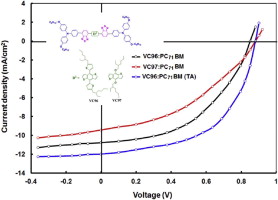Two molecules denoted as VC96 and VC97 have been synthesized for efficient (η = 6.13% @ 100 mW/cm2 sun-simulated light) small molecule solution processed organic solar cells. These molecules have been designed with the D1-A-D2-A-D1structure bearing different central donor unit, same benzothiadiazole (BT) as π-acceptor and end capping triphenylamine. Moreover, the optical and electrochemical properties (both experimental and theoretical) of these molecules have been systematically investigated. The solar cells prepared from VC96:PC71BM and VC97:PC71BM (1:2) processed from CF (chloroform) exhibit a PCE (power conversion efficiency) ofη = 4.06% (Jsc = 8.36 mA/cm2, Voc = 0.90 V and FF = 0.54) and η = 3.12% (Jsc = 6.78 mA/cm2, Voc = 0.92 V and FF = 0.50), respectively. The higher PCE of the device with VC96 as compared to VC97 is demonstrated to be due to the higher hole mobility and broader IPCE spectra. The devices based on VC96:PC71BM andVC97:PC71BM processed with solvent additive (3 v% DIO, 1,8-diiodooctane) showed PCE of η = 5.44% and η = 4.72%, respectively. The PCE device of optimizedVC96:PC71BM processed with DIO/CF (thermal annealed) has been improved up to 6.13% (Jsc = 10.72 mA/cm2, Voc = 0.88 V and FF = 0.61). The device optimization results from the improvement of the balanced charge transport and better nanoscale morphology induced by the solvent additive plus the thermal annealing.
